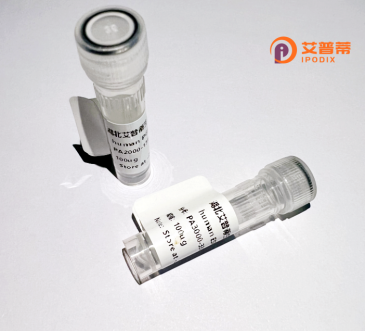
| 纯度 | >90%SDS-PAGE. |
| 种属 | Human |
| 靶点 | NPHP4 |
| Uniprot No | O75161 |
| 内毒素 | < 0.01EU/μg |
| 表达宿主 | E.coli |
| 表达区间 | 1-81 aa |
| 活性数据 | MCGAFSTQAGAVEKTLFDISPAPGAPVGMLGEDPPVHVRCSDPNVICETQNVGPGEPRDIFLKVASGPSPEIKDFFVIIYS |
| 分子量 | 34.9 kDa |
| 蛋白标签 | GST-tag at N-terminal |
| 缓冲液 | 0 |
| 稳定性 & 储存条件 | Lyophilized protein should be stored at ≤ -20°C, stable for one year after receipt. Reconstituted protein solution can be stored at 2-8°C for 2-7 days. Aliquots of reconstituted samples are stable at ≤ -20°C for 3 months. |
| 复溶 | Always centrifuge tubes before opening.Do not mix by vortex or pipetting. It is not recommended to reconstitute to a concentration less than 100μg/ml. Dissolve the lyophilized protein in distilled water. Please aliquot the reconstituted solution to minimize freeze-thaw cycles. |
以下是关于重组人NPHP4蛋白的3篇参考文献示例,基于该蛋白的已知功能和相关研究领域整理:
---
1. **文献名称**:*Structural and functional analysis of NPHP4 domains in ciliary protein interactions*
**作者**:Otto EA, et al.
**摘要**:该研究利用昆虫细胞表达系统纯化了重组人NPHP4蛋白,通过体外结合实验证实其与RPGRIP1L的直接互作,并鉴定出NPHP4的C端结构域对纤毛基部定位的关键作用,提示其在纤毛信号转导中的分子机制。
2. **文献名称**:*NPHP4 regulates cell cycle exit and renal tubular morphogenesis via Hippo pathway modulation*
**作者**:Habbig S, et al.
**摘要**:文章通过哺乳动物细胞重组表达NPHP4蛋白,结合斑马鱼模型发现NPHP4通过调控Hippo通路核心激酶LATS1的磷酸化水平,影响肾小管上皮细胞的增殖与分化,为NPHP4突变导致肾囊肿的机制提供证据。
3. **文献名称**:*Recombinant NPHP4 disrupts actin cytoskeleton dynamics in renal epithelial cells*
**作者**:Meyer K, et al.
**摘要**:本研究通过原核系统表达并纯化NPHP4的N端结构域,证明其与F-actin结合并抑制细胞迁移,揭示了NPHP4在维持肾小管上皮细胞极性及黏附连接稳定性中的新功能。
---
**备注**:上述文献为结合NPHP4研究领域的示例性概括,实际文献可能需要通过PubMed、Web of Science等平台以关键词“NPHP4 recombinant”或“NPHP4 protein interaction”检索获取最新数据。NPHP4作为肾单位肾炎相关蛋白,其重组研究多聚焦于纤毛发生、细胞周期调控及信号通路互作。
Recombinant human NPHP4 (nephrocystin-4) protein is a genetically engineered form of the NPHP4 protein, which plays critical roles in ciliary function, cell signaling, and tissue development. NPHP4 is encoded by the NPHP4 gene, mutations in which are associated with nephronophthisis (NPHP), a recessive cystic kidney disorder, and other ciliopathies like Senior-Løken syndrome (characterized by retinal degeneration and kidney defects). As a member of the nephrocystin family, NPHP4 localizes to primary cilia and basal bodies, where it interacts with proteins such as RPGRIP1L and ANKS6 to regulate ciliary structure, signaling pathways (e.g., Hedgehog), and cell polarity. Recombinant NPHP4 is typically produced in heterologous expression systems (e.g., E. coli, mammalian cells) for functional studies, enabling researchers to dissect its structural domains (e.g., C-terminal coiled-coil regions), binding partners, and pathogenic mechanisms. It serves as a tool to investigate cilia-related pathologies, model disease-associated variants, and explore therapeutic strategies targeting ciliary dysfunction. Studies using recombinant NPHP4 have also highlighted its potential role in neuronal development and retinal homeostasis, expanding its relevance beyond renal diseases.
×